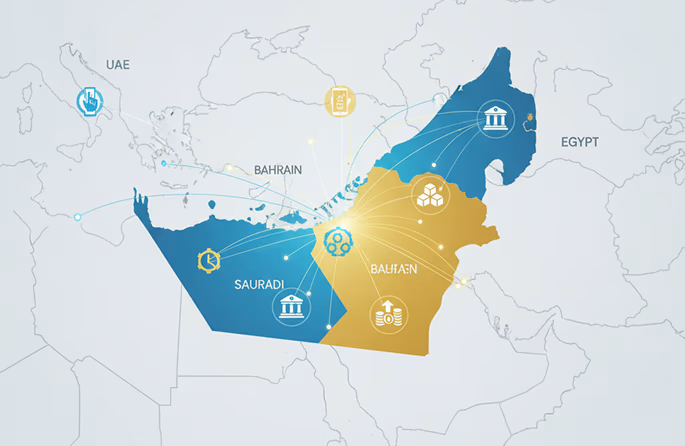Table of Contents
- Understanding the Concept of Regulatory Sandboxes
- The Rise of Fintech in the MENA Region
- How Sandboxes Accelerate Fintech Innovation
- Regulatory Sandboxes and Financial Inclusion
- Collaboration Between Banks and Fintech Startups
- The Future of Fintech Regulation in the MENA Region
- How Orbix Studio Empowers Fintech Innovation Through Design, Security and Compliance
- Conclusion

The financial landscape in the Middle East and North Africa (MENA) is entering a defining decade. Over the past few years, Fintech has disrupted traditional banking models and unlocked new forms of digital finance across payments, lending, insurance, and investments. Startups are moving faster than regulators ever anticipated, and governments are responding with new frameworks designed to encourage innovation responsibly.
Among these frameworks, regulatory sandboxes stand out as the most transformative. They allow Fintech startups, established financial institutions, and regulators to collaborate in controlled environments where new technologies can be tested safely. The sandbox concept ensures that innovation thrives without compromising consumer protection or financial stability.
Countries across the MENA region—most notably the UAE, Saudi Arabia, Bahrain, and Egypt—are now adopting sandbox programs that reflect both regional ambitions and global standards. The results are tangible: higher innovation rates, new investment flows, and a surge in Fintech confidence.
This article examines how regulatory sandboxes are driving Fintech innovation and market growth in MENA, their benefits and limitations, and how Orbix Studio supports Fintechs, banks, and governments in building secure, compliant, and scalable digital ecosystems within these frameworks.
Understanding the Concept of Regulatory Sandboxes

A regulatory sandbox is a framework that allows companies to test innovative financial products or services in a live environment under the supervision of a financial regulator. The goal is to encourage experimentation without the full risk of regulatory penalties or consumer exposure.
First introduced by the UK’s Financial Conduct Authority in 2016, sandboxes have since been replicated globally. Singapore, Australia, and Hong Kong followed with similar programs, and today MENA markets have adapted the model to suit regional financial structures.
These environments promote innovation while ensuring that consumer interests remain protected. By monitoring real-world testing, regulators can assess the risks and benefits of new technologies before granting broader approvals. This approach helps Fintech startups refine their products, build trust, and gain early insights into compliance expectations.
The Rise of Fintech in the MENA Region

The MENA region’s Fintech sector has grown at a rate that few predicted a decade ago. With a digitally savvy population, strong mobile penetration, and a growing appetite for financial inclusion, Fintech solutions have become vital to regional economies.
Startups are addressing long-standing gaps in access to credit, payments, and financial education. Governments, in turn, are investing in national strategies that promote digital transformation as a pathway to economic diversification.
Saudi Arabia’s Vision 2030 and the UAE’s Centennial 2071 strategies both identify Fintech as a key pillar for future growth. Bahrain has rebranded itself as a Fintech-friendly economy, while Egypt and Jordan are nurturing ecosystems around mobile banking and payments.
Amid this surge, regulatory sandboxes have emerged as the foundation for sustainable innovation. They enable Fintechs to test products within legal boundaries, helping the region strike a balance between progress and prudence.
MENA Governments Embracing the Sandbox Model
Across the region, regulators are actively shaping frameworks that welcome innovation. The Central Bank of the UAE created a sandbox program designed to accelerate financial digitalization and foster collaboration between banks and Fintech startups.
Saudi Arabia’s SAMA Sandbox aims to attract both domestic and international Fintechs that align with national payment and open banking initiatives. Bahrain’s Central Bank, through its Fintech Bay initiative, established one of the region’s first comprehensive sandboxes that integrate testing, mentorship, and funding support.
Egypt’s Central Bank has focused its sandbox efforts on promoting mobile payment solutions for rural inclusion. These initiatives collectively show how MENA governments are not merely adapting global models but tailoring them to regional needs—prioritizing inclusion, security, and innovation.
How Sandboxes Accelerate Fintech Innovation

Regulatory sandboxes streamline the Fintech innovation cycle. By reducing the bureaucratic hurdles traditionally associated with licensing, startups can focus on product development, user testing, and refinement.
The sandbox environment also encourages collaboration. Regulators provide early feedback, ensuring compliance standards are embedded from the beginning rather than added as an afterthought. For startups, this translates into faster market entry and stronger long-term sustainability.
Consider the example of Now Money, a UAE-based startup that promotes financial inclusion for low-income workers. Participation in the UAE’s sandbox allowed the company to test compliance-driven digital payroll and remittance systems. Once validated, Now Money was able to scale across the Gulf region confidently, setting a precedent for inclusive Fintech innovation.
Sandboxes, therefore, do more than validate ideas—they institutionalize innovation by turning regulatory engagement into a partnership.
Regulatory Sandboxes and Financial Inclusion

Financial inclusion remains one of MENA’s top economic priorities. Millions across the region still lack access to formal banking services, making Fintech solutions crucial for empowering underserved populations.
Through sandboxes, startups can safely test products that address these needs, such as digital wallets, peer-to-peer lending apps, or micro-savings platforms. Egypt’s sandbox, for example, supports startups focused on mobile money solutions for unbanked users. In Jordan, new Fintech initiatives are using sandbox frameworks to build lending tools for small business owners and freelancers.
These experiments are not just regulatory exercises—they are catalysts for social transformation. By encouraging innovation around accessibility, affordability, and trust, sandboxes play an instrumental role in closing the financial inclusion gap across MENA.
Strengthening Investor Confidence Through Regulatory Clarity
Investors thrive on clarity, and regulatory sandboxes provide just that. By giving startups an opportunity to operate under regulator supervision, sandboxes demonstrate that innovation can coexist with compliance.
Startups that graduate from sandbox programs signal a higher level of maturity, making them more attractive to venture capitalists and institutional investors. In Bahrain, sandbox-backed Fintechs have drawn funding from European and Asian investors who recognize the Kingdom as a Fintech innovation hub.
The sandbox ecosystem thus builds a feedback loop of trust: regulators provide structure, startups deliver innovation, and investors supply capital. This dynamic is reshaping how early-stage Fintech investment is perceived in emerging markets.
Collaboration Between Banks and Fintech Startups

The sandbox model also facilitates one of the most essential relationships in modern finance—the collaboration between legacy banks and emerging Fintech startups.
Banks have the customer base, infrastructure, and regulatory experience, while startups bring agility and new technology. In sandbox settings, both parties can collaborate without excessive legal exposure. The UAE’s Emirates NBD, for instance, has worked within sandbox frameworks to experiment with open banking integrations and co-develop API-driven financial services.
This partnership model turns potential competitors into collaborators. As a result, the Fintech ecosystem becomes more interconnected, and consumers benefit from improved products and services.
Challenges and Limitations of Regulatory Sandboxes

Despite their success, sandboxes face several practical challenges. Many startups encounter difficulty scaling once sandbox testing concludes. Compliance documentation, funding constraints, and cross-border regulatory differences can slow growth after initial success.
Additionally, there is still limited coordination between regional regulators. A startup approved in one country’s sandbox must often restart its application process when entering another market.
Regulators also face the delicate task of maintaining equilibrium—allowing innovation to thrive without compromising stability. Overregulation can stifle creativity, while underregulation risks systemic vulnerabilities. Maintaining this balance requires continuous dialogue between regulators, innovators, and ecosystem partners.
The Future of Fintech Regulation in the MENA Region

The next wave of Fintech regulation in MENA will focus on integration and shared standards. Cross-border sandboxes, data-sharing protocols, and digital identity frameworks will become essential for enabling scale.
Regional harmonization efforts through the Gulf Cooperation Council and pan-Arab Fintech networks are already underway. By 2030, the region could see unified sandbox programs that allow approved startups to operate across multiple markets seamlessly.
Emerging areas like RegTech, blockchain-based compliance, and AI-driven monitoring tools will further redefine how regulators and Fintechs interact. The MENA region’s focus on digital transformation positions it to become a global hub for responsible financial innovation.
Actionable Guide for Fintech Startups
Fintech startups aiming to join MENA sandbox programs should start by identifying the most relevant jurisdiction for their product. Each country’s framework differs in eligibility, testing scope, and compliance standards.
Before applying, startups should prepare a clear testing plan outlining the innovation’s purpose, risk management strategies, and measurable objectives. Collaborating with experienced compliance consultants or design agencies can help translate complex regulatory language into actionable development steps.
Once admitted, startups should maintain ongoing dialogue with regulators, integrating their feedback directly into the product development cycle. After completing the sandbox, a detailed evaluation report strengthens credibility and helps secure future licensing or funding.
Participation in a sandbox is not only a testing phase but a foundation for long-term regulatory relationships.
Opportunities for Financial Institutions and Investors
For established banks, regulatory sandboxes represent opportunities to modernize legacy operations. By participating in sandbox experiments, financial institutions can safely test open banking APIs, explore digital lending platforms, and adopt customer experience improvements with reduced risk.
Investors gain the advantage of early exposure to emerging technologies validated under regulatory supervision. This reduces uncertainty and accelerates due diligence processes.
In MENA, an increasing number of investors are partnering with regulators to identify promising Fintech ventures within sandbox pipelines. The result is a more transparent, stable, and innovation-driven investment environment.
The Next Phase of the MENA Fintech Ecosystem
The MENA Fintech sector is entering a maturity phase defined by regional collaboration and innovation grounded in regulation. Countries are aligning digital policies, cybersecurity standards, and data governance frameworks to support seamless operations across borders.
Design, compliance, and user trust will become the defining elements of successful Fintech platforms. As financial products become more digital, maintaining security, accessibility, and transparency will determine adoption rates and customer retention.
This convergence of innovation and compliance creates an opening for specialized partners capable of translating regulation into design, strategy, and execution—an area where Orbix Studio delivers substantial value.
How Orbix Studio Empowers Fintech Innovation Through Design, Security and Compliance
Fintech innovation does not succeed on technology alone. It requires strategic design, deep regulatory understanding, and a focus on digital trust. Orbix Studio helps Fintech startups, banks, and investors transform these elements into real, scalable outcomes that align with sandbox goals.
Orbix Studio works at the intersection of user experience, compliance, and financial technology. Our team partners with Fintechs to develop digital products that meet rigorous security standards while maintaining seamless usability. We understand the complexities of regulatory sandboxes—limited testing periods, compliance audits, data protection mandates—and we design digital solutions that thrive within these constraints.
Our consulting process begins with research. We analyze the specific sandbox framework a client operates in, interpret regulatory guidelines, and translate them into design and development requirements. Whether it involves digital identity verification, data privacy, AML compliance, or reporting dashboards, we ensure that every element of the Fintech product aligns with regulator expectations.
We also provides product compliance consulting and experience audits for Fintech startups preparing to enter or graduate from sandbox programs. This helps companies identify design-level risks, address user friction, and demonstrate compliance readiness during sandbox reviews.
Security is central to our approach. We collaborate with cybersecurity experts and engineers to integrate multi-layered protection into app architecture—from encryption and access control to fraud monitoring systems. By combining security with intuitive UX, we help Fintech platforms earn user trust, which is vital for financial adoption.
For banks and large financial institutions, Orbix Studio supports digital transformation initiatives that align with sandbox innovation goals. This includes redesigning legacy platforms, developing internal innovation portals, and creating dashboards that help compliance teams visualize testing outcomes.
Every project we undertake is guided by one principle: regulatory innovation should never compromise user experience. Our mission is to empower Fintechs to move confidently through sandbox environments and into full-scale market launch with products that are secure, compliant, and user-ready.
In doing so, Orbix Studio not only enhances the success rate of Fintech innovations but also contributes to the long-term stability and growth of the MENA financial ecosystem.
Conclusion
Regulatory sandboxes are redefining Fintech across the MENA region. They represent a model of progressive regulation that empowers startups to innovate while protecting consumers and ensuring market integrity. The outcomes are clear—more financial inclusion, higher investor confidence, and a steady flow of innovation across borders.
Yet for innovation to translate into real impact, Fintechs and financial institutions must combine technology with compliance, design, and trust. This is where Orbix Studio plays a vital role. By helping organizations align with sandbox standards through research-driven design, security integration, and compliance consulting, Orbix enables Fintech innovation that is both visionary and sustainable.
The MENA region’s Fintech journey is only beginning. The frameworks being built today will define the next decade of financial progress, and partners like Orbix Studio are helping ensure that innovation is not only fast but also safe, compliant, and human-centered.
Frequently Asked Questions (FAQ)
1. What is a regulatory sandbox in Fintech?
A regulatory sandbox is a framework set up by financial authorities that allows Fintech companies to test new products or services in a controlled environment under regulatory supervision before full-scale launch. It helps balance innovation with consumer protection.
2. Why are regulatory sandboxes important for the MENA region?
They provide a structured way for MENA countries to encourage Fintech growth while managing risk. By supporting controlled experimentation, sandboxes help attract investment, foster inclusion, and build investor confidence.
3. Which MENA countries have active regulatory sandboxes?
The UAE, Saudi Arabia, Bahrain, and Egypt currently lead with established sandbox frameworks. Jordan and Oman are also developing structured initiatives to support Fintech testing.
4. How do regulatory sandboxes benefit Fintech startups?
Startups gain early regulatory guidance, reduced compliance barriers during testing, and faster time to market. Successful sandbox participation often increases credibility with investors and financial institutions.
5. What are the main challenges of regulatory sandboxes?
Common challenges include post-sandbox scalability, differing rules across countries, limited funding, and maintaining compliance once the controlled testing phase ends.
Fresh UI/UX Ideas, Straight to Your Inbox





